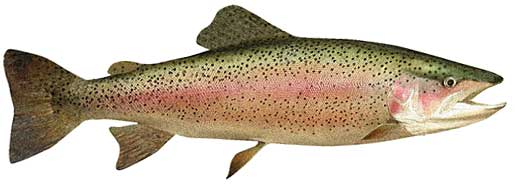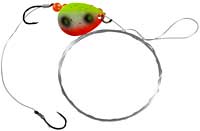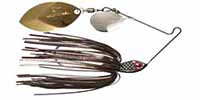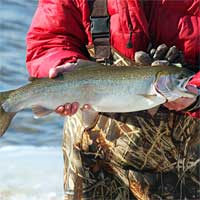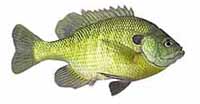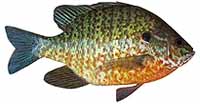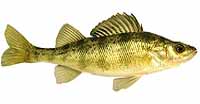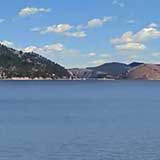Fishing Report For Canyon Ferry Lake, MT
By Rick Seaman
September 26, 2025
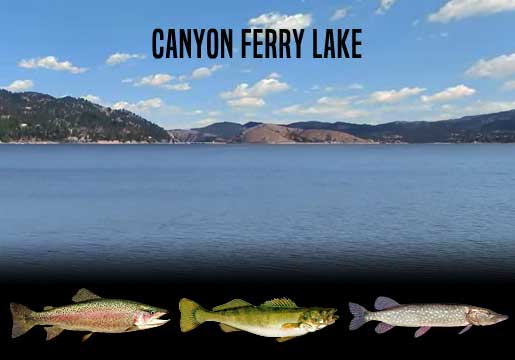
Fishing Reports
Popular Fish Species Canyon Ferry Lake, MT
Rainbow Trout
Current Report: Good To Very Good
Fly fishing is not covered in this website, but rainbow trout are being caught on plenty of other lures and bait.
FALL. Cooling water temperatures in the shallows, draw rainbow trout out of deeper Summer depths. Anglers are now catching them 5 to 15 feet deep on rocky banks, wind-blown points, rocky structure, humps, and anywhere baitfish are gathering. Now that they had a full summer to grow, there are some nice size rainbow to be caught. Small spinners, spoons, jigs, miniature crankbaits and swimbaits are good choices, as are salmon eggs and prepared baits. Later in Autumn, they move into 15 to 25 feet of water.
WINTER. When Winter sets in, and the lake freezes over, jigging spoons, and jigs tipped with bait, are catching nice limits of rainbows out of 20 to 35 feet of water. After ice out, deep trolling with leaded line or downriggers, or vertical jigging with spoons and jigs, are the best approach during the cold-water season.
SPRING. As water begins to warm in early Spring, rainbow trout move from their late winter holding areas to shallow, warmer water 5 to 15 feet deep. A good number of rainbows are typically caught from mid morning to late afternoon, during the warmest water of the day. Shallow flats, weedy areas, and rocky structure are quick to warm in the afternoon sun. A wide variety of small spinners, spoons and bait are catching most of the fish.
SUMMER. Once Summer is here to stay, the warmer water drives rainbow deeper, 20 to 35 feet deep, occasionally deeper. Trolling with spoons, spinners and crankbaits, using downriggers or leaded line, and drift fishing with bait, are currently the most productive methods. Following drop-offs into deeper water, along structure or creek channels, is a major key to getting bites. Anglers fishing from the bank are using nightcrawlers or Berkley PowerBait, with heavy weights on a Carolina rig, to get baits in deeper water.
Walleye
Current Report: Very Good
Spring and Fall are the best seasons for catching walleye, as they spend a great deal of time in shallower water.
FALL. Fall brings cooler temperatures to shallow water, drawing walleye and baitfish shallower. Jigs, swimbaits, spoons, crankbaits, jerkbaits, and spinnerbaits are all historically good for catching walleye this time of year. Early Fall finds them in 15 to 30 feet of water. Later in Fall, they move out deeper again. Dragging jigs or worm harnesses with nightcrawlers or leeches, or bottom bouncers, around ledge drop-offs catches walleye fairly consistently. Watch for the bigger walleye to be slightly deeper than the majority of the school.
WINTER. This Winter fishing for walleye was pretty good through the ice. Before, during and after the ice, anglers report catching them in 30 feet deep and deeper, along creek channel edges, rocky humps and ledges. They primarily feed on small fish, staying close to the bottom. After ice-out blade baits, jigs, swimbaits, spoons, deep-diving crankbaits, and worm harness spinners, are all working while deep trolling or slow drifting.
SPRING. Early Spring brings warming water in the shallows, and draws walleye here to feed, especially rocky areas and inlet channels. Here, in 10 to 20 feet deep, they will spawn once the water warms to the mid to high 40's. When they move shallow, bright colored jigs, tipped with minnows or nightcrawlers. Spinnerbaits, jerkbaits and crankbaits are also working when walleye are up shallow. Afterwards, they move to 15 to 25 feet deep around shallow points, flats, shoals and ledges, nearby shore, often staying in close proximity to their spawning locations.
SUMMER. Water temperatures rise in Summer, and walleye fishing is good if you can get your bait deep enough. Early in the season, walleye tend to concentrate in 15 to 20 feet of water. Once Summer heat warms the water walleye move to 25 to 35 feet deep,preferring the cooler temperatures. Throughout Summer, early in the morning, and from dusk to long after dark are good times to catch walleye. At those times they move slightly shallower to feed in low-light conditions. Night fishing is often good in Summer, as well. The rest of the time they are cruising flats and creek channel edges, where they are harder to locate. When the bite is slow, grubs and nightcrawlers, fished just off the bottom are catching walleye.
Northern Pike
Current Report: Good To Very Good
FALL. As the weather starts turning cold, water temperatures cool fastest in the shallows. This brings baitfish into shallower waters, and northerns follow this food source. They hang out in 5 to 15 feet of water, around weedbed edges, main-lake points, reefs, and rocky shorelines to ambush prey. This is a prime feeding time as they prepare for winter. It is also a good time to catch a trophy pike.
WINTER. Pike remain active in Winter, often congregating in or near remaining weedbeds, especially along the edges. Other structure options include long points, reefs, ledge drop-offs, and rocky humps, ideally nearby deeper water. Ice fishing was good here in winter. At times, when oxygen is depleted in deeper water, northerns suspend directly under the ice, where maximum oxygen is available. Other times they hold on structure in 15 to 30 feet of water, sometimes deeper.
SPRING. After ice out, northern pike migrate into 2 to 8 feet of water, in warmer pockets, bays and coves. Once water temperatures reach around 40 degrees, they move into even shallower areas with vegetation, to spawn. After spawning they linger in the shallow bays for a short period. Once water temperatures rise into the 50's, they move to deeper weedbeds and shallow structures adjacent to even deeper water. Bright colors, whites and flashy lures appeal to these predators. Noisy topwater lures can also produce some spectacular strikes. Alternate between baits until you identify which one triggers the most bites for the day.
SUMMER. Northern pike scatter all around the lake, rather than gather in groups. This makes them difficult to locate. During the day they are holding from 10 to 20 feet deep, on ledges, reefs, weedbeds, rock piles, islands and channel edges. Some of the larger specimens are suspending in open water, just outside feeding areas. Trolling or drift fishing produces some nice catches, using spoons, big spinners, cut bait, and deep diving crankbaits. Early and late in the day, they move shallow to feed and can be caught around most weedy shorelines. Noisy topwater lures, spinnerbaits and Johnson spoons with curly-tail grubs, are catching nice pike shallow in 2 to 8 feet of water.
Fishing Video
Fish species to fish for...
Guide to fishing for largemouth bass, smallmouth bass, rainbow trout, cutthroat trout, brook trout, brown trout, bluegill, pumpkinseed sunfish, yellow perch and northern pike at Canyon Ferry Lake in Montana.
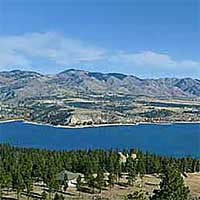
Canyon Ferry Lake is a 26,000-acre lake with 76 miles of shoreline.This thriving lake is home to rainbow trout, yellow perch, northern pike, and smallmouth bass. Numerous locations around the lake provide access for fishing from the bank. In winter, there is excellent ice fishing for trout and perch.
Primary fish species to catch
Click images for fishing tips and details about each species.
Today's Weather & Forecast
Fishing Boat Rentals
Click here for fishing boat rentals.
Public Boat Launch Ramps & Landings
Click here for boat ramps.
Marinas
Click here for marinas.
Fishing License
Click here for a Montana Fishing License.
Map - Fishing & Access
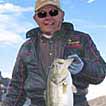
Rick Seaman is a fishing enthusiast with over five decades of fishing experience, a retired tournament fisherman, author of numerous published articles on fishing, and co-author of the book "Bass Fishing - It's not WHAT you throw, It's WHERE you throw it".
Contact Information
Kim's Marina & Resort
8015 Canyon Ferry Rd
Helena, MT 59602
406 475-3723
Fishing lakes in each state
092625
Canyon Ferry Lake, Montana Report
MONTANA


Information about fishing lakes in Montana
Fishing in west-central Montana for bass, trout, sunfish, perch and pike.


